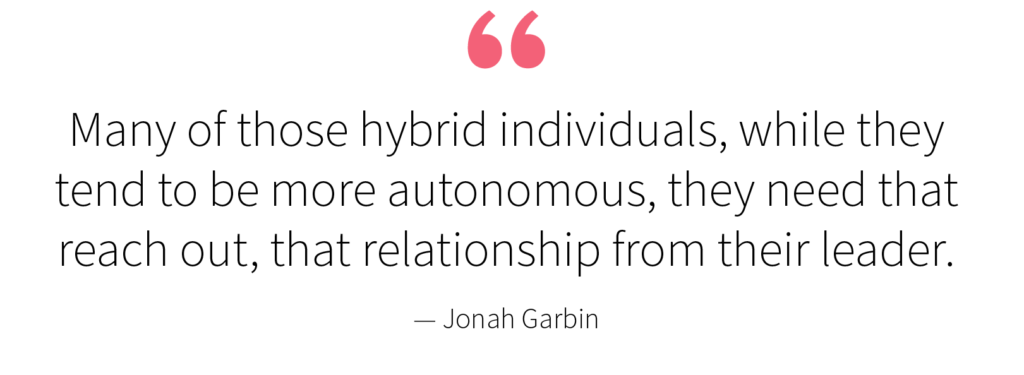
Retaining an organization’s workforce can be a challenge in today’s talent market, but there are some key principles that every leader should employ to keep their top talent over the long haul.
In a recent Talent Plus webinar about retention, John Henley moderated a conversation between Jonah Garbin and Scott C. Whiteford, Ph.D. — the authors of our recent white paper. Jonah and Scott discussed the challenges of retaining top talent and provided valuable strategies for organizations. They reiterated the importance of building strong relationships between leaders and team members, aligning strengths and themes among leaders and team members, and investing in individualized support. Here are the highlights.
Focus On Relationships
Research shows that employees need relationships with their managers, and a lack of one can lead to high turnover rates among top performers. Employees spend so much time at work that they require one-on-one time with those around them — including their leaders — to feel valued, engaged, and motivated to stick around.

“So what we know from the research is that employees, given that they spend so much of their time at work, they are desperate to have relationships,” says Garbin. “And it’s not just relationships with their clients or their customers or their coworkers. They’re desperate to have meaningful relationships with their leaders.”
Although it may be easier to allow your top talent to work on autopilot, you should still “prioritize the one-on-one relationships,” advises Henley. “Initiate relationships to increase employee engagement, loyalty and performance.”
Spend The Most Time With The Most Talented People
The tendency for many is to spend the most time with their less talented employees — but don’t do that, says Whiteford. “If you could create a top 10 or a top 15 or a top five of the employees that report to you and rank them on productivity on one side and on the amount of time you spend with them on the other, we should see parallel lines,” he says. “You should be spending the most time with your most valuable players.”

Relationships Start With Onboarding
The best relationships begin with onboarding. It shouldn’t just be “‘Follow Bob, here’s the computer, and good luck,’” says Whiteford. “Instead, have that Career Investment Discussion with them from day one and day 30, day 90, 360, whatever it is that’s most appropriate to really understand where they are and how to build that relationship with them.”
Hybrid Work Makes Relationship-Building Even More Essential
Garbin and Whiteford also addressed the challenges of hybrid work environments, emphasizing the need for leaders to prioritize relationship-building and communication with remote employees through regular check-ins and virtual meetings.
“The relationship theme was even more essential [in hybrid work environments],” says Garbin. “It means text messages, phone calls, FaceTime meetings, reaching out to those people and saying, ‘Hey, how are things going?’… Putting just your face on when you go into a FaceTime and turning on your camera. Setting up a meeting where you could connect…. Many of those hybrid individuals, while they tend to be more autonomous, they need that reach out, that relationship from their leader.”

Build From Your Strengths
Even leaders who aren’t strong in providing an individualized approach can still form good relationships with their employees. These leaders should rely on “building compensatory strategies” based on other leadership talents, says Whiteford.
You can also align by particular themes, says Garbin. “So maybe you have these go-getters who aren’t necessarily a people person, but you also are a go-getter, you actually have a better chance of connecting with those individuals because you’re very like-minded,” he states. “You’re hungry, I’m hungry, let’s go be hungry together. And we have seen from some of our analyses that has worked to compensate for individuals who are low in those people acumen themes.”
Surround Talent With Talent
Along with relationships, top performers are most engaged when they work with other all-stars on a team and have a talented leader.

“It isn’t enough just to have a top performer, place ’em somewhere and expect them to lift everything within that business unit or organization,” says Henley. “It really happens when all of the folks on the team are strong as well as the leader.”
A talented team is much like a sports team, claims Garbin. They want to be around other all-stars with an all-star coach.
A Mismatch In Talent Leads To Lower Engagement
Our research shows that talented individuals on a talented team with a less talented leader were the least engaged. “The vice versa was true,” explains Garbin. “If you were a less talented team, but you had a super-talented leader, you were the least engaged.”
How To Get The Most Engagement
Our research shows that if you want a talented individual to be very engaged, put them to work with a bunch of other talented team members and a super-talented leader.
“Those individuals were the most engaged,” says Garbin. “We’ve studied hospitality, healthcare, retail, manufacturing… across varying sizes of companies, 200 to 200,000. This result has stayed the same. Talented individuals with a talented team and a talented leader were the most engaged, were the highest performing, were the most likely to grow in their performance, were the most loyal to the organization, and were the least likely to term.”
Support Each Individual
Leaders should invest in their employees’ professional growth by creating a plan that allows their talent to flourish and providing individualized support through various means like financial compensation, communication, resources and training.

Top performers need managers to invest in their professional growth. And many people take this to mean onboarding, training, and pay raises. But investment is much more than that. It means challenging them to grow and develop.
“Great leaders figure out a way to light a fire inside of somebody instead of under them,” says Henley. “It’s the difference between calling somebody in instead of calling them out.”
What Does Investment Look Like?
Real investment means individualized relationships, financial compensation, communication, resources and training. More importantly, investment also means exciting new responsibilities and energizing new roles that allow people to express themselves and their talents.
If you can give that to your talented employees, says Garbin, “those individuals who are your top performers are the most satisfied and most engaged in your organization.”
Invest On An Individual Level
One important note: investment must be individualized and focused on strengths, says Whiteford. “It’s not just about ‘we’re going to treat everybody’s same. Everybody has the same onboarding plan, everybody has the same growth plan.’ No. In fact, we want to see different investments for different folks.”

Investment involves many aspects of an employee experience, from relationship to pay and training to new experiences. “You are dynamically adjusting each of these,” reminds Garbin, “in order to maximize their growth, increase their employee empowerment, and continue quality performance.”
Invest In Strengths
When it comes to investing in strengths, Whiteford advises focusing on the positive. “The more you invest in what people do well, the more productive they’re going to be, the more satisfied they’re going to be, the more engaged they’re going to be,” he says. “If you focus on what they do not do well, the less engaged they’re going to be and the more likely they’re going to leave.”
Yes, It’s Challenging — But Worth It
Even with the very best talent and the very best investment, leading talented employees is difficult. “Leading top performers can be challenging,” says Whiteford. “They want to continue to grow, they want to continue to achieve. They’re the group that says ‘if it ain’t broke, let’s break it. Let’s make it better’”
The important thing to focus on is to continue to invest. Think: “What more responsibility can I give them? What more things can I do to set them up for success?” advises Garbin. Many times, that means encouraging them to do something they’ve never done before. “In order to do that well, you have to be hungry, you have to be ambitious, and you have to be willing to learn.”
Activate Talent, Retain Talent
Overall, our research points to the importance of building strong relationships, aligning strengths among leaders and team members, and investing in individual employees to drive success in today’s rapidly changing workforce. “No two people are the same, and everybody has talent to perform at a high level,” says Whiteford.
We hope you’ve found these insights helpful in activating your own talented team members. Watch the live recording of our retention webinar, and follow us on LinkedIn for more thought leadership on talent.
Talent Plus
Talent Plus is a team of industry experts who collaborate to deliver insightful and impactful content. Our blogs are designed to provide practical advice and fresh perspectives, helping you stay informed and ahead of the curve.
Latest Posts: Blog

Blog November 04, 2025
Top Performers, Explained: Karl Giuseffi’s Blueprint to Thrive
Explore insights from Karl Giuseffi on how talent science enhances workplace success and team performance.
Read More
Blog October 22, 2025
Practical Ways to Give Feedback That Strengthens Talent and Growth
Learn how to give good feedback that inspires and builds trust among your team while enhancing their natural strengths.
Read More
Blog September 25, 2025
What Do We Really Mean When We Talk About Talent?
Unlock the secrets of talent in the workforce. Learn how to identify inherent abilities for excellence in your team.
Read More
Blog July 08, 2025
How to Manage Difficult People
Master how to manage difficult people at work with six effective strategies for maintaining productivity and engagement.
Read More
Selection April 28, 2025
The Science of Talent Reduces Turnover in Credit Unions
Learn how Credit Unions use Talent Plus Solutions to decrease turnover, better engage employees and increase performance.
Read More
Blog April 25, 2025
Building a Better Healthcare Team: Nebraska Spine Hospital’s Data-Driven Talent Approach
Find out how Nebraska Spine Hospital partners with Talent Plus to enhance employee engagement and organizational culture.
Read More

